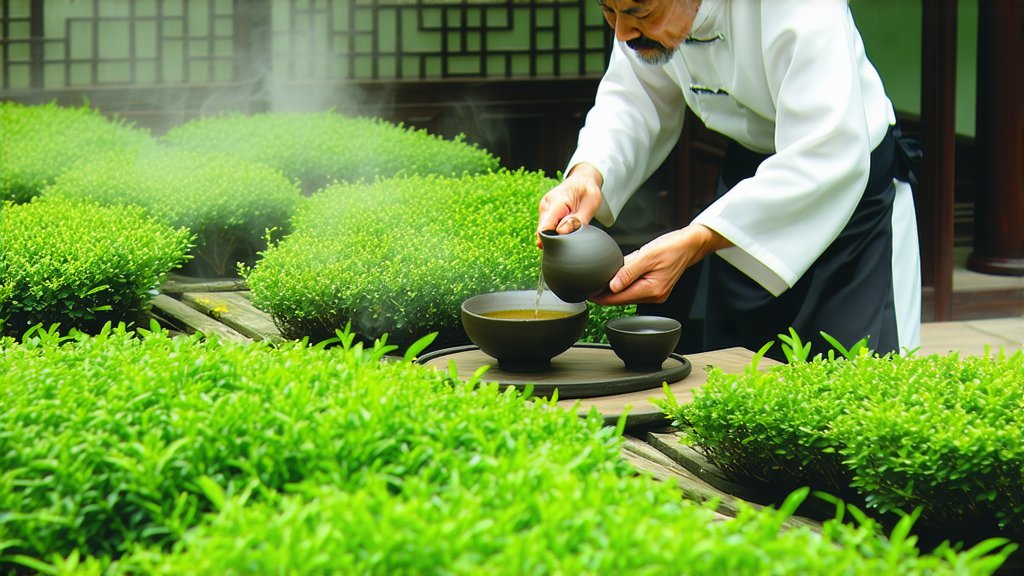
Tieguanyin, often referred to as the "Iron Goddess of Mercy," is one of the most renowned varieties of Chinese Oolong tea. This exquisite tea originates from Anxi County in Fujian Province, China, and has a rich history that spans several centuries. In this article, we will delve into the historical background, types, production process, and tasting techniques associated with Tieguanyin tea.
Historical Background
Tieguanyin tea traces its roots back to the Ming Dynasty (1368-1644). According to legend, it was discovered by a poor scholar named Wei Yin who found an unusual tea plant growing on a rock face in the Anxi region. The tea produced from these leaves possessed a unique flavor and aroma that captivated Wei Yin, leading him to cultivate more of these plants. Over time, the tea gained popularity and became known as "Tieguanyin" after a local Buddhist temple dedicated to the Iron Goddess of Mercy.
Types of Tieguanyin
Tieguanyin can be broadly categorized into two main types: Anxi Tieguanyin and Taiwanese Tieguanyin. Anxi Tieguanyin, also known as Fujian Tieguanyin, is the original variety that comes from the Anxi region in Fujian Province. Taiwanese Tieguanyin, on the other hand, was introduced to Taiwan in the early 20th century and has since developed its own unique characteristics.
Anxi Tieguanyin
Anxi Tieguanyin is characterized by its tightly rolled pellet shape and dark green color. It has a complex flavor profile that includes floral notes, fruity undertones, and a hint of sweetness. The aroma is often described as orchid-like, with a subtle roasted finish.
Taiwanese Tieguanyin
Taiwanese Tieguanyin, also known as High Mountain Oolong, is typically lighter in color and has a more pronounced floral aroma compared to its Anxi counterpart. It is grown at higher altitudes, which contributes to its crisp, clean taste and smooth texture. The flavor profile is more delicate, with floral and buttery notes.
Production Process
The production of Tieguanyin tea involves several meticulous steps that ensure the final product retains its unique flavor and aroma. Here's an overview of the traditional production process:
-
Plucking: Only the youngest leaves and buds are harvested, usually by hand. This ensures that the tea maintains its freshness and quality.
-
Withering: The freshly plucked leaves are spread out to wilt under the sun. This process reduces moisture content and prepares the leaves for the next stages.
-
Bruising: After withering, the leaves are tossed and turned to create friction, which helps to release the natural juices and enzymes within the leaves. This step is crucial for developing the tea's flavor and aroma.
-
Fixation: The leaves are then quickly heated to stop the oxidation process. This preserves the green color and prevents the leaves from turning brown.
-
Rolling: The fixed leaves are rolled into tight pellets using specialized machines or by hand. This shaping process helps to extract more flavors during brewing.
-
Roasting: The rolled pellets are then roasted over charcoal or in modern roasters. This step adds depth to the tea's flavor and aroma, giving it a characteristic roasted note.
-
Sorting and Grading: Finally, the tea is sorted and graded based on size, shape, and quality. The highest quality leaves are selected for premium grades.
Tasting Techniques
To fully appreciate the nuances of Tieguanyin tea, it is essential to follow proper tea tasting techniques. Here is a guide to help you enjoy this exquisite beverage:
-
Warm the Teapot: Begin by rinsing your teapot with hot water to warm it up. This helps to maintain the optimal temperature for brewing.
-
Measure the Tea: Use about 5 grams of Tieguanyin tea per 150 ml of water. Place the leaves in a gaiwan or Yixing clay teapot for the best results.
-
Steeping Time: For the first infusion, steep the tea for about 30 seconds. Subsequent infusions can be steeped for longer periods, typically around 1 minute each time. Adjust the steeping time based on your personal preference for strength and flavor.
-
Pouring: When pouring the tea, use a gentle circular motion to ensure even extraction of all the leaves. This technique helps to avoid bitterness and maximizes the tea's flavor profile.
-
Smelling the Aroma: Before taking your first sip, take a moment to inhale the aroma of the tea. Notice any floral, fruity, or roasted notes that stand out.
-
Savoring the Taste: Take small sips and let the tea roll around your mouth to fully experience its complexity. Pay attention to the initial flavors, followed by the mid-palate and aftertaste. Note any changes in flavor throughout subsequent infusions.
Conclusion
Tieguanyin tea is a testament to the artistry and dedication of Chinese tea culture. Its rich history, diverse varieties, intricate production process, and sophisticated tasting techniques make it a beloved choice among tea enthusiasts worldwide. Whether you prefer the robust flavors of Anxi Tieguanyin or the delicate notes of Taiwanese Tieguanyin, there is something truly magical about this Iron Goddess of tea that continues to captivate and inspire.